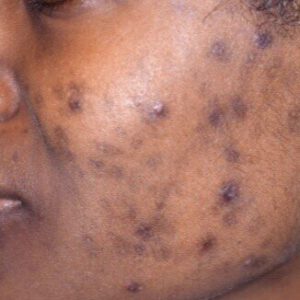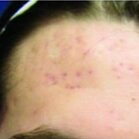ACNE
ACNE SCARRING
Acne scarring consists of two major components: textural changes and pigment changes.
Textural changes are a result of damage and scarring to the deeper layers of skin (Dermis and subcutis).
Pigment changes as a result of increased blood flow or pigment deposition from inflammation.
DARK PIGMENT
 Dark pigment is caused by increased melanin in the top layers of the skin as a result of inflammation related to acne and may be treated by:
Dark pigment is caused by increased melanin in the top layers of the skin as a result of inflammation related to acne and may be treated by:
Sun Protection and Time are very effective at reducing hyperpigmentation. Broad-spectrum sunscreen at least SPF 30, Avoidance during peak sun hours (10:00 – 2:00), sun-protective clothing (hats), and shade can be very effective.
Hydroquinone is a prescription medication that reduces pigment in the skin. This should not be used more than 8 weeks at a time and breaks of 4-8 weeks should be taken.
Retinoid medications can reduce hyperpigmentation, but also make you more sensitive to the sun, so being excellent with sun protection is important.
Certain types of lasers can be effective at reducing pigmentation such as the q switched and pico second lasers in the appropriate wavelength. Laser treatment can be dangerous and can also lead to the worsening of pigmentation, so this should only be done through a licensed medical professional.
Chemical Peels, similar to lasers, can be helpful under certain circumstances, but may also lead to worsening of hyperpigmentation if not performed appropriately, and should only be done under the supervision of a medical professional.
Azelaic Acid is a prescription that can treat hyperpigmentation and acne.
Kojic Acid non-prescription topical.
RED PIGMENT
 Red pigment is caused by increase blood in the area of acne secondary to inflammation and may be treated by:
Red pigment is caused by increase blood in the area of acne secondary to inflammation and may be treated by:
Sun Protection and Time while this is a somewhat unsatisfying treatment option, redness will fade with time if new inflammation is not occurring. Your acne must be under excellent control to prevent continued inflammation.
Laser Treatment with lasers targeting red-pigment can be very helpful (Pulsed Dye Laser, Intense Pulsed Light), but also have significant risks and should only be performed with a trained medical professional.
Niacin and Vitamin C can reduce redness and are non-prescription topical treatments.
